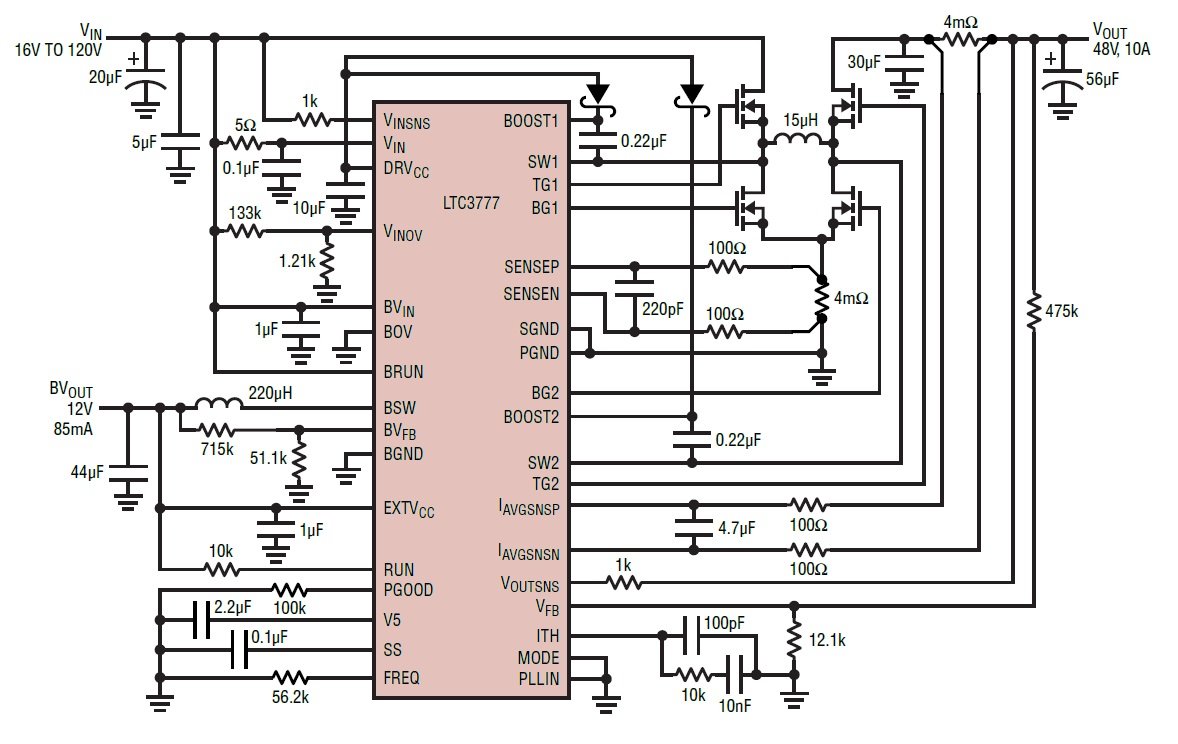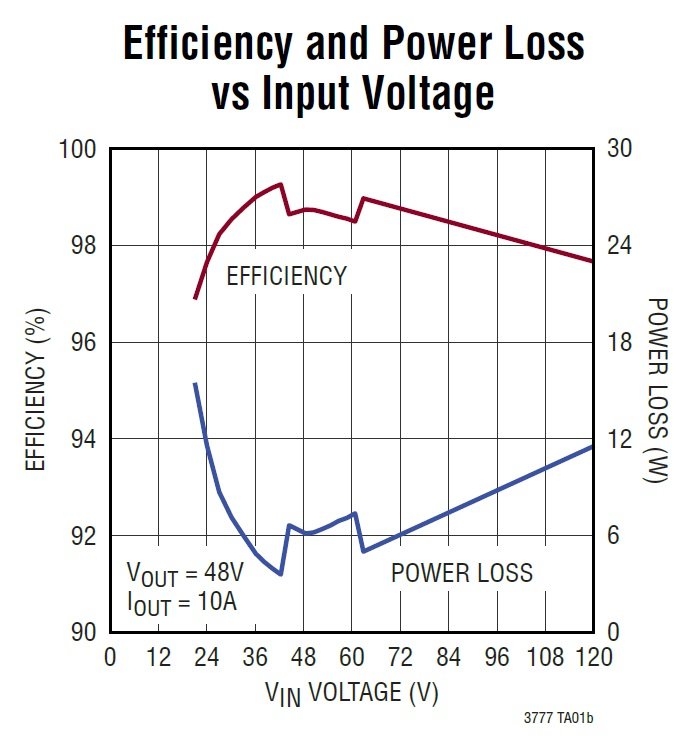A four-switch DC/DC controller that operates from input voltages above, below, or equal to the regulated output voltage.
Linear Technology, now part of Analog Devices, has announced the LTC3777, which is a 48-pin, high performance, four-switch buck-boost switching regulator controller that operates from input voltages above, below, or equal to the output voltage, hence the term buck-boost.
According to its datasheet, this controller uses a proprietary current mode control architecture for achieving constant frequency in buck, boost, or buck-boost modes of operation. And while many external components, both active and passive, are required (see the figure below), perhaps that's a small price to pay given all the features that this IC offers; we'll discuss some of the features below.

The LTC3777 requires many external components. This typical application circuit is from the datasheet (PDF).
High Voltage: At 150 V, They Aren't Kidding
Depending on the choice of external components, this device is able to generate an output voltage ranging from 1.2 V to 150 V from an input voltage range of 4.5 V to 150 V (see the figure below). However, if your design calls for an input voltage of less than 4.5 V, don’t give up on this part just yet, because note 4 (see the figure below) tells us that operation from an input voltage lower than 4.5 V is possible when the IC is biased from an auxiliary supply through the EXTVCC pin.

The LTC3777 offers a wide VIN and VOUT voltage range, up to 150 V max. Table taken from the datasheet (PDF).
Seriously High Efficiency
According to the datasheet section entitled Integrated Switching Bias Supply, achieving high-efficiency levels across a wide range of load currents is made possible, in part, by the integrated switching bias supply, which is a synchronous step-down regulator with internal power switches that utilize "burst mode" control. Burst mode, which as the name implies uses short "burst" cycles, incorporates sleep cycles, during which the power switches are turned off and the load current is supplied by the output capacitor; sleep-cycle operation requires a mere 12 µA of supply current.
In the figure below, Linear Tech shows us a plot of the IC's efficiency—which looks to be a bit over 99%, say 99.2%—along with a plot of the IC's power loss. I personally have not seen power loss displayed like this before (i.e., together with efficiency), and I wonder what value this power loss information offers above and beyond the efficiency plot.
Do you have experiences to share where this type of power loss information has proven useful? If so, please pass along the details in the comments section.

Power loss (for 480 W output power) and efficiency, from the datasheet.
The figure below shows us a circuit for achieving a 99% efficient, 480 W, 48 V output converter. So, if your own design requirements meet the specs of this example, then perhaps half your design challenge is complete since Linear Tech has even provided part numbers for a few of the components.

An example implementation, from the datasheet (PDF).
Some Help for the Designer...
This IC certainly won’t be as easy to implement as numerous other DC/DC converters that require few external components. Fortunately, to help designers with this challenge, Linear Tech has provided—within the datasheet—sixteen pages (pages 20 to 36) of application information, tips, hints, and suggestions: selection of components (such as MOSFETs, inductors, and diodes), adjusting the overvoltage and undervoltage lockout settings, checking the IC's transient response, and so on. They even provide a PCB layout checklist. And Linear Tech would probably be happy to assist you further if you were to kindly reach out to them.
Before we finish up, it’s worthwhile to say a few words about datasheet quality. Semiconductor companies are publishing some mediocre datasheets these days, and it is greatly appreciated when time is taken to produce clear, comprehensive product literature that goes the extra mile in attempting to help the engineer understand and successfully implement an IC. This Linear Tech document certainly represents the higher-quality end of the datasheet spectrum: example circuits, six pages of multicolored performance plots, a carefully drawn block diagram showing the internal functionality, timing diagrams, the extensive applications information mentioned above…. Nicely done, Linear Tech.
Have you had an opportunity to use this new buck-boost controller in any designs? If so, leave a comment and tell us about your experiences.
